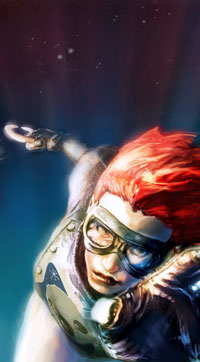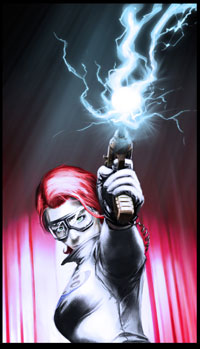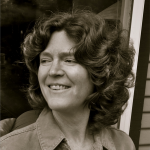Essay by Karen J. Ohlson
Heroic Adventures in the Land of the Small-Minded
At my work-study job in the English Department library, I overheard plenty of dirty little secrets: which professors loathed each other, who was sleeping with whom, and what English majors said about their less literary peers.
“Here’s what I’ve realized about math majors,” declared a smug, beret-topped girl to a circle of friends propped against bookcases and tipped back in library chairs. “Math majors… have sterile minds.”
 As she paused to let her profundity sink in, her friends gave minute, considering nods.
As she paused to let her profundity sink in, her friends gave minute, considering nods.
Meanwhile, my own math-major mind immediately pictured a multitude of creative humiliations I would love to inflict on her—such as giving her the head of an ass, à la Shakespeare’s Bottom. But I kept my mouth shut.
I was young. Young and shy. I didn’t have the nerve to butt into this conversation among strangers and to out myself as “bi”—that is, a bidisciplinary student of both math and writing.
Still, I yearned to burst their stereotypes. Enjoying both math and writing had seemed perfectly natural to me from an early age. After all, they’re not mutually exclusive skills. We don’t assume that a person who’s good at, say, art can’t do math. Or can’t be good at writing or sports or science.
Yet, in the decades since I overheard that “sterile minds” comment, I’ve encountered any number of people professing the incompatibility of math and writing—and surprised to hear that my career path has included both.
So, I’ve learned to fight back. These days, when I hear a comment implying that math and writing inhabit separate worlds, I swoop in like a crime-stopping superhero.
“Not so fast!” I say, squaring my shoulders as if tossing back a cape to better display the imaginary insignia on my chest: a Venn diagram of two sets with a shining gold zone of intersection. “Math and writing are alike in more ways than you think. Let’s… do the math!”
Or, channeling Elizabeth Barrett Browning: “Let me count the ways.”
1. Math and Writing Create Order Out of Chaos
Writers use words to better understand what they think or feel about something—and to shape those thoughts and feelings into a coherent and aesthetically pleasing form.
Just as writing can turn the raw input of impressions, observations, and emotions into a poem or story, math can turn raw data into statistics that convey something meaningful: a baseball player’s RBIs, a car’s miles per gallon, or women’s earnings as a percentage of men’s.
Math can also help us find significant relationships between measured quantities, such as carbon dioxide emissions and a rise in global temperatures—turning a vast collection of measurements into a wake-up call regarding the fate of the planet.
2. Math and Writing Involve Inspiration
 The creativity in writing is obvious, but there’s plenty of creativity in math as well. Often a problem can be solved in multiple ways—algebraically, experimentally, geometrically—and sometimes there’s a less obvious, but more elegant, way to solve a problem that involves a creative leap.
The creativity in writing is obvious, but there’s plenty of creativity in math as well. Often a problem can be solved in multiple ways—algebraically, experimentally, geometrically—and sometimes there’s a less obvious, but more elegant, way to solve a problem that involves a creative leap.
At times, solving a particularly complex problem may require a flash of inspiration. Once, in high school, I was stuck on how to proceed with a proof for my geometry homework. So I went off to take a shower.
While I was standing under the hot water and letting my thoughts drift, the solution popped into my brain, triggering a whoop of joy—the first of many such shower-borne realizations in my life.
I would later learn that the original “Eureka moment” also involved math and bathing: the famous mathematician Archimedes’s realization in a bath that an object’s displacement of water was the key to finding out whether a crown of a given mass was pure gold rather than a less dense alloy.
“Eureka!” he shouted (Greek for “I have found it!”), as he ran naked down the street. Or so the story goes.
3. Math and Writing Rely on Logic
Just as a mathematical proof requires a logical progression of steps, writing involves expressing your thoughts clearly and with transitions that help readers follow the logic of what you’re saying.
One of my tasks as an editor is to find places where the writer’s leap from thought to thought has left me behind. (“Huh? How did we get from there to here?”) By working with the writer to add transitions or by restructuring the piece altogether, I can make the logic more apparent and keep future readers from getting lost.
4. Math and Writing Play with Patterns
Thinking mathematically often involves looking for patterns in numbers and data that help us draw conclusions and make predictions. Writing often uses patterns to create an effect—not just in structured poetic forms such as haiku, sonnets, and sestinas, but also in free verse and prose.
All writing has rhythms and sound patterns, whether the writer is conscious of creating them or not. Any time we use repetition of words, phrases, or sounds, we’re playing with patterns.
Consider how the repeated “b,” “t,” and “s” sounds in this sentence from F. Scott Fitzgerald’s The Great Gatsby create their effect:
So we beat on, boats against the current, borne back ceaselessly into the past.
These sound elements convey what it feels like to be in one of the bobbing, wave-slapped boats.
 5. Math and Writing Help Us to Communicate
5. Math and Writing Help Us to Communicate
Finally, think of how often you see a news story accompanied by charts, graphs, and statistics. You may need words to explain what the numbers and charts represent, but the numbers also tell their own story in a succinct way.
Equations tell another type of story without words—the essence of a relationship conveyed with just two dashed lines: =.
Summing Up
Of course, every stereotype-busting intervention requires its own particular script.
If I did have superpowers—ones that let me travel through time—I’d go back to that English Department moment and confront Ms. “Math Majors Have Sterile Minds” with this question: “If mathematicians have sterile minds, how do you think they came up with imaginary numbers, pi, and infinity?”
SHAZAM!
 Karen J. Ohlson is the reviews editor of Talking Writing.
Karen J. Ohlson is the reviews editor of Talking Writing.
In her post-college career, she experimented with many ways of combining her math and writing skills (statistical analyst ... and tech writer! tech writer ... and simulation builder! magazine editor ... at a computer magazine!) before admitting to herself that writing and editing pulled her most strongly.
"SHAZAM!" is an acronym for six ancient heroes and conferred on Captain Marvel the wisdom of Solomon, the strength of Hercules, the stamina of Atlas, and so on. If Karen possessed “the power of SHAZAM!,” it would call forth the eloquence of Shakespeare, the magic of Hecate, the mathematical brilliance of Archimedes, the panache of Zorro, the wit of Ms. Austen, and the sky-leaping strength of Moon Girl—for flying in the face of convention, of course.
Artist
 Rahzzah has been drawing for as long as he’s been able to hold a pencil. Most recently, he helped bring Clara Lune back to life in the 2010 reboot of Moon Girl. The reboot, a comiXology title by Tony Trov, Johnny Zito, and Rahzzah, is being published by Red 5 Comics as a five-part comic book series.
Rahzzah has been drawing for as long as he’s been able to hold a pencil. Most recently, he helped bring Clara Lune back to life in the 2010 reboot of Moon Girl. The reboot, a comiXology title by Tony Trov, Johnny Zito, and Rahzzah, is being published by Red 5 Comics as a five-part comic book series.
More of Rahzzah’s artwork can be viewed on DeviantArt.
If TW Production Editor Hadley Langosy ever decides to get a tattoo, she will ask him to design it.
